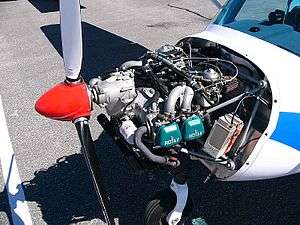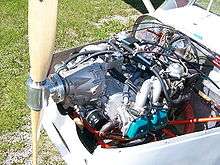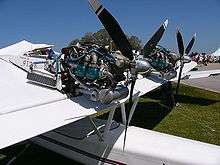Rotax 912
| Rotax 912 | |
|---|---|
 | |
| Rotax 912ULS 100 hp (75 kW) installation in a 3Xtrim 3X55 Trener | |
| Type | Piston aircraft engine |
| National origin | Austria |
| Manufacturer | Rotax Aircraft Engines |
| Major applications | Light sport aircraft Ultralight aircraft |
| Variants | Rotax 914 Rotax 915 iS |



The Rotax 912 is a naturally aspirated, air- and water-cooled, horizontally opposed four-cylinder, four-stroke, gear reduction-drive engine commonly used on certified aircraft, light sport aircraft, ultralight aircraft and unmanned aerial vehicles. Rotax produced its 50,000th 912-series engine in 2014.[1]
Development
The original 80 hp (60 kW) 912 UL engine has a capacity of 1,211 cc (73.9 cu in) and a compression ratio of 9.1:1. The later 912S / ULS is enlarged to 1,352 cubic centimetres (82.5 cu in) and has a compression ratio of 10.8:1, yielding 100 hp (75 kW). The 912 A and F are used in certified aircraft, such as the Diamond DA20, which is quite popular in Europe. The 100 hp (75 kW) versions are used in many light sport aircraft, such as the Zenith STOL CH 701 and the Tecnam P2002 Sierra. The 80 hp (60 kW) versions are sufficient to power the new generation of efficient motorgliders, such as the Pipistrel Sinus and the Urban Air Lambada. It is also fitted to some light twins, such as the Tecnam P2006T.
The engine differs from conventional aircraft engines (such as the Lycoming O-235) in that it has air-cooled cylinders with liquid-cooled heads[2] and uses a 2.43:1 gearbox (PSRU) to reduce the engine's relatively high 5,800 rpm shaft speed to a more conventional 2,400 rpm for the propeller. On the 912A, F and UL the standard reduction ratio is 2.27:1 with 2.43:1 optional. Lubrication is dry sump, and fuelling is via dual CV carburetors or fully redundant electronic fuel injection. The electronic fuel injected Rotax 912iS is a recent development.[2] A further derivative, the 135 hp (101 kW) Rotax 915 iS was announced in July 2015.[3]
Early 912 series engines have a shorter time between overhaul (TBO) than traditional engines, but are more fuel efficient than similarly sized engines, e.g., Continental O-200. Effective 14 December 2009, 912 engines have had their recommended Time Between Overhauls (TBO) raised from 1,200 hours to 1,500 hours, or 1,500 hours to 2,000 hours, depending on serial number.[4] In addition to the lower fuel consumption they are certified to run on automotive fuel (mogas), further reducing running costs, especially in areas where leaded AVGAS is not readily available.[2] The engines are popular in Europe and in United States Light Sport Category aircraft due to high power-to-weight ratio, low fuel costs and relatively quiet operation.
On 8 March 2012 the company displayed its 912 iS variant, a 100 hp (75 kW) version with fuel injection and an electronic engine management unit.[5] The version weighs 63 kg (139 lb), which is 6 kg (13 lb) more than the standard 912S. The non-certified 912 iS targets the Light Sport and Experimental market and 912 iSc will be certified. Production started in March 2012 and the engine has a 2000-hour recommended time-between-overhaul to start.[6]
On 1 April 2014 the company announced its new 912 iS Sport upgrade with greater power and torque and reduced fuel consumption.[7]
Warnings
Unlike most other manufacturers of similar engines, Rotax provides extensive warnings in the owner’s manual, about both the certified and non-certified versions of the engine design, warning pilots that the engine is not suitable for use in situations where a safe landing cannot be made, for use in rotorcraft, for night flying (unless equipped with redundant electrical power), or for aerobatics. It furthermore states that the company gives no assurances that the engine is suitable for use in any aircraft, that the "engine may seize or stall at any time. This could lead to a crash landing and possible severe injury or death" and that "non-compliance [with the warnings provided] can result in serious injuries or death!"[8]
Variants
The engine is available in the following versions:
- 912 A#
- Certified to JAR 22, 80 hp (60 kW)
- 912 F#
- Certified to FAR 33, 80 hp (60 kW)
- 912 iS
- Uncertified, 100 hp (75 kW) with direct fuel injection and an electronic engine management unit[6]
- 912 iSc
- Certified, 100 hp (75 kW) with direct fuel injection and an electronic engine management unit[6]
- 912 iS Sport
- Uncertified, aluminum airbox, longer intake runners and eco-mode when operated below 97% power setting.[9][10]
- 912 S#
- Certified to FAR 33, 100 hp (75 kW)
- 912 UL#
- Uncertified, 80 hp (60 kW)
- 912 ULS#
- Uncertified, 100 hp (75 kW)
- 912 ULSFR#
- Uncertified French Authority specification. 100 hp (75 kW)
The # in the designation stands for:
- Shaft with flange for fixed pitch propeller, P.C.D. 100 mm
- Shaft with flange for fixed pitch propeller, P.C.D. 75 mm, P.C.D. 80 mm and P.C.D. 4 inches
- Shaft with flange for constant speed propeller P.C.D. 75 mm, P.C.D. 80 mm, P.C.D. 4 inches and drive for hydraulic governor for constant speed propeller
- Shaft with flange for fixed speed propeller P.C.D. 75 mm, P.C.D. 80 mm, P.C.D. 4 inches also can be fitted with an adaptor, drive and governor for a constant speed propeller.
Applications
- 3I Sky Arrow
- 3Xtrim 3X55 Trener
- Acrolite
- Advanced Aeromarine Buccaneer II
- Aero Adventure Aventura II & XLR
- AeroAndina MXP-150 Kimbaya
- AeroAndina MXP-158 Embera
- Aero & Tech Nexth
- Aero AT-3
- Aero Bravo Bravo 700
- Aero Bravo Sky Ranger
- Aerocomp VM-1 Esqual
- Aero Designs Pulsar
- Aeroflying Sensation
- Aero-Kros MP-02 Czajka
- Aeromobil 3.0
- Aeroprakt A-20
- Aeroprakt A-22
- Aeroprakt A-28 Victor
- Aeroprakt A-36 Vulcan
- Aeros-2
- Aeros Cross Country
- Aerosette MH-46 Eclipse
- Aerostar R40S Festival
- Aeros UL-2000 Flamingo
- Aeropilot Legend 540
- Aerospool WT9 Dynamic
- Aero Synergie J300 Joker
- Aero Synergie Jodel D20
- Airbet Girabet
- Airborne Edge
- Airborne XT
- Air Command Tandem
- Air Copter A3C
- Air Creation Clipper
- Air Creation Skypper
- Air Creation Tanarg
- Airflow Twinbee
- AirLony Skylane
- Airmak J4
- AirMax SeaMax
- Airo 1
- Airtrike Eagle 5
- Albaviation D24 MagicOne
- Alisport Yuma
- Alpi Pioneer 200
- Alpi Pioneer 300
- Alpi Pioneer 300 Kite
- Alpi Pioneer 400
- AMD Zodiac
- AAC Seastar Sealoon
- Anglin J6 Karatoo
- Antares MA-34
- Antonov T-2M Maverick
- Apollo Delta Jet
- Apollo Fox
- Apollo Jet Star
- Apollo Monsoon
- Apollo Racer GT
- Aquila A 210
- ARV Griffin
- ARV Super2 (aftermarket installation)
- ATEC 122 Zephyr 2000
- ATEC 212 Solo
- ATEC 321 Faeta
- Australian Aircraft Kits Hornet STOL
- Australian Lightwing GR 912
- Australian Lightwing SP-2000 Speed
- AutoGyro MT-03
- AutoGyro Calidus
- AutoGyro Cavalon
- Avama Stylus
- Aveko VL-3 Sprint
- Aviadesign A-16 Sport Falcon
- Aviakit Vega
- Aviasouz Cruise
- Aviastroitel AC-5MP
- Aviate Raptor
- AVIC Lucky Bird
- Avid Flyer
- Aviomania Genesis Duo G2SA
- Aviomania Genesis Solo G1SA
- AV Leichtflugzeuge Vagabund
- BAaer Guri
- Bauer BAD-12 Gyrotrainer
- BDC Aero Puma
- Best Off Nynja
- Best Off Sky Ranger
- Bilsam Sky Cruiser
- ASAP Chinook Plus 2
- B&F Fk9
- B&F Fk12
- B&F Fk14 Polaris
- Bayraktar Tactical UAS
- Blackshape Prime
- Blue Yonder Merlin
- Blue Yonder Harvard
- Blue Yonder King Cobra
- Blue Yonder EZ Flyer
- Blue Yonder Twin Engine EZ Flyer
- BOT SC07 Speed Cruiser
- BRM Aero Bristell
- BRM Argos
- BRM Land Africa
- Bushcaddy R-80
- Bushcaddy R-120
- Buzzman L'il Buzzard
- Caldas 2G7 Vento
- Capella XLS
- Carlson Sparrow
- CBB O2
- Celier Kiss
- Celier Xenon 2
- Celier Xenon 4
- Celier XeWing
- CFM Air Dardo
- CFM Shadow
- Chernov Che-25
- Coavio DF 2000
- Colomban MC-100 Ban-Bi
- Colyaer Freedom S100
- Colyaer Gannet S100
- Colyaer Martin3 S100
- Cosmos Phase III
- Criquet Storch
- CSA PS-38 Tourer
- CZAW Parrot
- CZAW SportCruiser
- Dallach Sunwheel
- Dallair Aeronautica FR-100 Snap!
- DAR 21 Vector II
- Denney Kitfox
- Diamond DA20-A1 Katana
- Diamond HK36 Super Dimona
- Didier Pti'tAvion
- Direct Fly Alto
- Direct Fly ArGO
- Distar UFM-13 Lambada
- Dorna Parandeh Abi
- Dorna Free Bird
- Dova DV-1 Skylark
- Drachen Studio Kecur Royal 912
- DTA Combo
- DTA Evolution
- DTA Feeling
- DTA J-RO
- Dyn'Aéro MCR01
- Dyn'Aéro MCR4S
- Dyn'Aéro Twin-R
- Dynali H2S
- Dynali H3 EasyFlyer
- Eagle EA-100
- EDM Aerotec CoAX 2D/2R
- Egvoyager Voyager 203
- Ekolot JK-05L Junior
- Ekolot KR-030 Topaz
- ELA 07
- ELA 10 Eclipse
- ELA 09 Junior
- Elitar-202
- Elitar Sigma
- Etudes Andre Morin M85
- Euro-ALA Jet Fox
- Eurodisplay SR-01 Magic
- Euro Fly Flash Light
- Euro Fly FB5 Star Light
- Europa XS
- Evektor SportStar
- Evolution Revo
- Exkluziv Joker
- Falconar AMF-14H Maranda
- Fantasy Air Allegro
- FD-Composites ArrowCopter
- Fisher Dakota Hawk
- Flaeming Air FA 04 Peregrine
- Flight Design CTSW
- Flight Design MC
- Flight Team Twister
- Flying Legend Hawker Hurricane Replica
- Flying Machines FM250 Vampire
- Flying Machines FM301
- Flyitalia MD3 Rider
- Fly Synthesis Storch
- Fly Synthesis Syncro
- Fly Synthesis Texan
- FMP Qualt 201
- Freewind Bumble B
- Foxcon Terrier 200
- G1 Aviation G1
- General Aviation Design Bureau T-32 Maverick
- Gidroplan Che-22 Korvet
- Glasair GlaStar
- Gobosh 700S
- Gobosh 800XP
- Golden Avio F30
- Golden Circle Air T-Bird
- HB-Flugtechnik Amigo
- HB-Flugtechnik Cubby
- HB-Flugtechnik Dandy
- HB Flugtechnik HB-207 Alfa
- Houde Bimax
- Humbert La Moto Du Ciel
- General Atomics MQ-1 Predator
- IAE VUT Marabou
- IAR-46
- Ibis GS-501 Urraco
- Ibis GS-600 Arrow
- Ibis GS-700 Magic
- Ibis GS-710 Magic
- Icarus F99 Rambo
- Icon A5
- ICP Amigo
- ICP Savannah
- ICP Vimana
- Ikarus C42
- Ikarus C52
- InterPlane Skyboy
- Ion Aircraft Ion
- Jihlavan Skyleader
- Jingmen A2C Ultra Seaplane
- Junkers Profly Ultima
- Just Escapade
- Just Highlander
- Just Superstol
- Kappa 77 KP 2U-SOVA
- Keitek Streamer
- Kohl Mythos
- Kolb Kolbra
- Kolb Mark III Xtra
- Kolb Slingshot
- Kubicek M-2 Scout
- Lamco Eurocub
- Laron Wizard
- LH-10 Ellipse
- Liberty XL2
- Light Wing AC4
- Lilienthal Bekas
- LISA Akoya
- Lockwood Aircam
- Lockwood Super Drifter
- Magni M-14 Scout
- Mainair Blade
- Marawing 1-L Malamut
- Medway Av8R
- Medway EclipseR
- Medway SLA100 Executive
- Microleve Corsario
- Millennium Master
- Moyes Dragonfly
- MSL Aero H80
- M-Squared Breese
- Murphy Renegade
- New Avio C205
- Nexaer LS1
- Niki Kallithea
- Norman Aviation J6 Karatoo
- Norman Aviation Nordic II
- Norman Aviation Nordic VI
- Norman Aviation Nordic 8 Mini Explorer
- North American Rotorwerks Pitbull II
- North Wing Sport X2
- Nova Coden
- OneAircraft One
- OSKBES MAI-208
- Pagotto Brako
- Pagotto Brakogyro
- P&M Explorer
- P&M PulsR
- P&M GT450
- Paradise P-1 LSA
- PC-Flight Pretty Flight
- Pegasus EDA 100 Flamingo
- Pegasus Quantum
- Pegasus Quik
- Pelegrin Tarragon
- Phantom II
- Phoenix Air Phoenix
- Piper Sport
- Pipistrel Alpha Trainer
- Pipistrel Sinus
- Pipistrel Virus
- Pro.Mecc Freccia Anemo
- Pro.Mecc Sparviero
- Progressive Aerodyne SeaRey
- Quicksilver GT500
- RagWing RW19 Stork
- RagWing RW22 Tiger Moth
- RagWing RW26 Special II
- Rainbow Aerotrike
- Rainbow Cheetah
- Ramphos Trident
- Rans S-6 Coyote II
- Rans S-7 Courier
- Rans S-10 Sakota
- Rans S-11 Pursuit
- Rans S-12 Airaile
- Rans S-16 Shekari
- Rans S-19 Venterra
- Rans S-20 Raven
- Remos GX
- RMT Bateleur
- Roland Me 109 Replica
- Roland S-STOL
- Roland Z-602
- Roko Aero NG4
- Rokospol Via
- Rossi Shuttle Quik
- Rutan SkiGull
- SAB C-100 Vulcan
- Shark.Aero Shark
- Scheibe Falke
- SkyCruiser Autogyro SkyCruiser
- Skyline SL-122 Pchelka
- Skyeton K-10 Swift
- Skyleader GP One
- SkyReach BushCat
- Skyrider Stingray
- Summit 2
- Sunward Aurora
- Sunward ST912
- Sunward STB912
- S-Wing Swing
- Skyleader 200
- Sea and Sky Cygnet
- Slepcev Storch
- SlipStream Genesis
- Softeks V-24 Lastochka
- Solo Wings Aquilla
- Sport Copter Vortex
- Stellar Astra
- Storm 280
- Storm 300
- Storm 320E
- Storm RG Fury
- Swiss Excellence Risen
- Synairgie Jet Ranger
- Taiwan Dancer TD-3
- Tecnam Astore
- Tecnam P 92
- Tecnam P 96
- Tecnam P2002
- Tecnam P2004
- Tecnam P2006T
- Tecnam P2008
- Tecnam Snap
- Terrafugia Transition
- Titan T-51 Mustang
- Titan Tornado
- Titanium Explorer
- TL Ultralight TL-3000 Sirius
- TL-Ultralight Stream
- TMM Avia T-10 Avia-Tor
- Tomark Skyper
- Tomark Viper
- Triavio Italo
- Trike Icaros Adventure S
- Trixy G 4-2 R
- Trixy Liberty
- Trixy Princess
- ULBI Wild Thing
- Ultra-Leicht Flugtechnik Speedy Mouse
- Ultravia Pelican
- Urban Air Samba
- US Light Aircraft Hornet
- Van's Aircraft RV-12
- Vervoost FV-3 Delphin
- ViS Sprint
- ViS ViS-3
- Weller UW-9 Sprint
- Whisper Aircraft Whisper
- World Aircraft Spirit
- World Aircraft Vision
- WLT Sparrow
- Zenith STOL CH 701
- Zenith STOL CH 750
Specifications (Rotax 912 UL/A/F)
General characteristics
- Type: four-cylinder, four-stroke liquid / air-cooled engine with opposed cylinders, dry sump forced lubrication with separate oil tank, automatic adjustment by hydraulic valve tappet, dual CD carburetors, mechanical diaphragm pump, electronic dual ignition, electric starter, integrated reduction gear 1 : 2.273 or 1 : 2.43
- Bore: 79.5 mm (3.13 in)
- Stroke: 61 mm (2.40 in)
- Displacement: 1,211.2 cm3 (73.91 in3)
- Length: 561 mm (22.1 in)
- Width: 576 mm (22.7 in)
- Dry weight: 60 kg (132.3 lb) with electric starter, carburetors, fuel pump, air filters and oil system
Components
- Valvetrain: OHV, hydraulic lifters, pushrods, rocker arms
- Fuel type: Unleaded: 87 octane AKI (Canada/USA) / 90 octane RON (European) or higher. Leaded fuel and AVGAS 100 LL can be used but are not recommended.
- Oil system: Dry sump with trochoid pump, camshaft driven
- Cooling system: Liquid-cooled cylinder heads, air-cooled cylinders
Performance
- Power output: 59.6 kW (79.9 hp) at 5,800 rpm
- Specific power: 48.71 kW/L
- Compression ratio: 9:1
- Fuel consumption: 15.0 liters/h at 5,000 rpm (75% power)
- Specific fuel consumption: 285 g/(kW·h) at 5,500 rpm (maximum continuous power)
- Power-to-weight ratio: 980 W/kg
See also
Comparable engines
- Arrow 1000
- D-Motor LF26
- Hirth 3701
- Hirth F-30
- HKS 700E
- Jabiru 2200
- KFM 112M
- Pegasus PAL 95
- Revmaster R-2300
- Sauer S 2200 UL
- Sauer S 2100 ULT
- Sauer S 2400 UL
- ULPower UL260i
Related lists
References
- ↑ "Rotax Rolls Out 50,000 912-Series Engine". Retrieved 7 June 2014.
- 1 2 3 Rotax (September 2012). "Operators Manual for Rotax engine type 912 series" (PDF). Retrieved 21 June 2015.
- ↑ "Rotax-Owner.com - ROTAX 915 IS: BRP UNVEILS A NEW TURBOCHARGED ROTAX AIRCRAFT ENGINE". rotax-owner.com. Retrieved 22 July 2015.
- ↑ Rotax (December 2009). "Extension of Time Between Overhauls (TBO) for Rotax Engine Type 912 and 914 (Series)" (PDF). Retrieved 2010-02-11.
- ↑ "Rotax Introduces 921iS". Sport Aviation: 14. May 2012.
- 1 2 3 Bertorelli, Paul (8 March 2012). "BRP/Rotax Rolls Out New Engine". AVweb. Retrieved 14 March 2012.
- ↑ "Rotax lowers fuel burn, boosts performance with 912 iS Sport". aopa.org. Retrieved 22 July 2015.
- ↑ BRP-Rotax (1 September 2012). "Operators Manual Rotax Type 912 Series" (PDF). Archived from the original (PDF) on 30 June 2014. Retrieved 5 August 2014.
- ↑ Sport Aviation: 14. May 2014. Missing or empty
|title=(help) - ↑ "Rotax 912 iS: Better than predicted". generalaviationnews.com. 27 June 2013. Retrieved 10 August 2016.
External links
| Wikimedia Commons has media related to Rotax 912. |